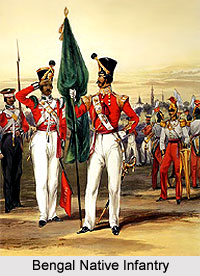 The 2nd Regiment of Bengal Native Infantry was an infantry battalion of the British East India Company that existed from the year 1798 to 1922. It was a part of the Bengal Native Infantry under the Army of the Bengal province, before the beginning of the Indian rebellion of the year 1857. The Bengal Army was the armed forces of Bengal Presidency and was amongst the 3 main Presidency Armies in British India. The army unit was also incorporated as a part of the Bengal Command. The 2nd Regiment of Bengal Native Infantry was also known as the 2nd Queen Victoria`s Own Rajput Light Infantry and as the 2nd Rajputs. King Edward VII acted as the Colonel-in-Chief of the battalion in the year 1904. The battalion was formed in the year 1798; and later in 1922 it was amalgamated with 5 other Rajput regiments.
The 2nd Regiment of Bengal Native Infantry was an infantry battalion of the British East India Company that existed from the year 1798 to 1922. It was a part of the Bengal Native Infantry under the Army of the Bengal province, before the beginning of the Indian rebellion of the year 1857. The Bengal Army was the armed forces of Bengal Presidency and was amongst the 3 main Presidency Armies in British India. The army unit was also incorporated as a part of the Bengal Command. The 2nd Regiment of Bengal Native Infantry was also known as the 2nd Queen Victoria`s Own Rajput Light Infantry and as the 2nd Rajputs. King Edward VII acted as the Colonel-in-Chief of the battalion in the year 1904. The battalion was formed in the year 1798; and later in 1922 it was amalgamated with 5 other Rajput regiments.
History of 2nd Regiment of Bengal Native Infantry
In the year 1798, the British East India Company developed a 2nd Battalion for the 15th Regiment of Bengal Native Infantry. The unit fought at Laswari, Delhi, Bharatpur and Deeg. The 2nd Battalion was granted an honorary colour for providing loyal service in the Second Anglo Maratha War under the command of General Lake. It was detached from the 15th Regiment in the year 1828 in order to establish the 31st Regiment of Bengal Native Infantry. The initial military campaign of the regiment was in the First Anglo Afghan War in the year 1839. The 2nd Rajputs were granted 3 battle honours for their participation in the Second Anglo Sikh War. Later the battalion was honoured with 2 battle honours for the battles of Gujarat and Chillianwala.
The 2nd Regiment of Bengal Native Infantry did not participate in the Great Revolt of 1857, also known as the Sepoy Mutiny in 1857, and fought in the Central India Campaign. Most of the regiments in the Army of Bengal Presidency had rebelled and consequently the regiments of the armed force were dissolved. As a result the 31st Regiment of Bengal Native Infantry became the 2nd senior most battalion. The regiment was renamed as the 2nd (Queen`s Own) Regiment of Bengal Native Light Infantry after Queen Victoria was appointed as the Empress of India in the year 1876. Later the 2nd Regiment of Bengal Native Infantry participated in the Second Afghan War.
During World War I, two extra units were formed in 1917 and in 1918. The regiment provided service in the conquests of Afghanistan, Mesopotamia and Egypt. During the
Dissolution of 2nd Regiment of Bengal Native Infantry
After the completion of the First World War, the British Government of India restructured and re-organized the Indian army. The separate single battalion infantry regiments were merged together in order to develop multi battalion regiments. As a result, the regiment was merged with the 4th Rajputs, 7th Rajputs, 8th Rajputs, 11th Rajputs, and 16th Rajputs in order to establish the 7th Rajput Regiment in 1922. The 2nd Rajputs held its title after becoming the 1st Battalion.
After the nation achieved independence from the rule of the British Empire in India in the year 1947, the nation was divided into the Union of India and the Dominion of Pakistan through the Partition of India. The British Indian Army was divided amongst the 2 nations and the 2nd Rajputs were assigned to India. Later the battalion was raised to Guard status and changed to the Brigade of the Guards as the 4th Battalion.
Members of the 2nd Regiment of Bengal Native Infantry
* Field Marshal Sir Henry Wylie Norman
* Major General Corrie Hudson
* Field Marshal Kodandera Madappa Cariappa



















